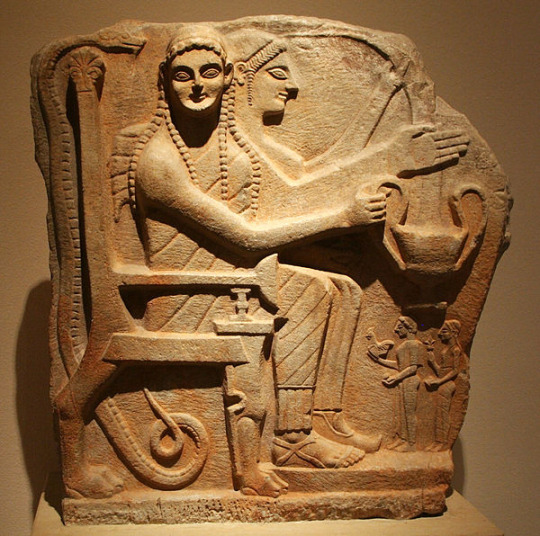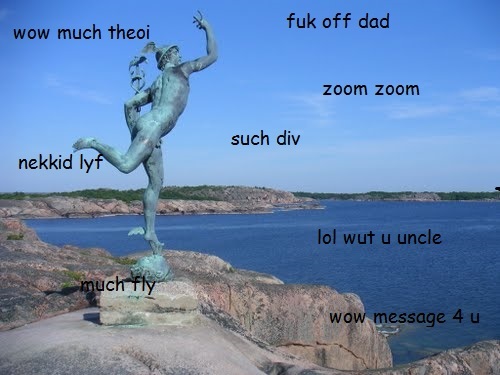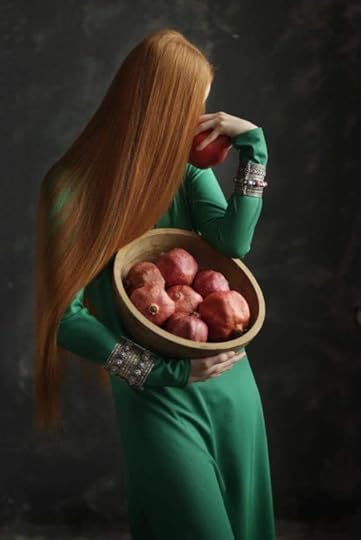Rachel Alexander's Blog, page 382
October 11, 2016
garden-of-vegan:
Pomegranate Seeds
October 10, 2016
songbirdspells:
Hermes memeus: god of memes
artist-who-doesnt-paint:
Me, before beginning of study of Greek mythology: I love Hades and...
Me, before beginning of study of Greek mythology: I love Hades and Persephone, especially Persephone.
Me, after beginning of study of Greek mythology: I LOVE HADES AND PERSEPHONE, ESPECIALLY PERSEPHONE
October 9, 2016
Yes, I completely agree. Do you buy chance have a list of sources to use in order to research more the Hades and Persephone myth?
Yes!
If I had to pick just two to begin with: Hymn to Demeter + Helene Foley’s book on this Hymn.
The huge list (copied from another post of mine plus some edit).
Greek/Roman sources:
Hymn to DemeterHesiod - TheogonyOrphic HymnsOvid’s Metamorphoses (Book V) and Fasti (Book IV)The Odyssey (Book 10 and 11)Claudian - Rape* of Persephone (means *abduction).Plato’s Cratylus.
Euripides’ Helen and Eumenides.Aristophanes’ Frogs and Thesmophoriazusae.
Others:
HARD, Robin: The Routlege Handbook of Greek Mythology: is a book on general mythology but it has chapters for Hades, Demeter and Persephone and I find it super useful as good myth introduction.FOLEY, Helene; The Homeric Hymn to Demeter: it’s a great book for learning about the Hymn to Demeter, is not hard to read and I think is also available for Scribd suscription if you wanna read online.CLAY, Politics of Olympus: just one chapter of this book is about the Hymn to Demeter, but is a nice one if you want to complement the previous one.WRIGHT, Dudley; The Eleusinian Mysteries & Rites: a very short and easy to read book about Eleusis cult.
DETIENNE, Marcel; Gardens of Adonis: good for understand myth and greek religious rites connection, and Persephone relation to Thesmophoria and the myth of Mint.SUTER, Ann; The Narcissus and the Pomegranate: this is a feminist scholar that defends Persephone and Hades relationship. Personally I found it a bit difficult to read, but might be easier for English native speakers -I’m not one.KERENYI, Karl; Eleusis: Archetypical Image of Mother and Daughter: this is another nice book that focuses on Persehone’s myth and Eleusis cult.Redfield, James; The Locrian Maidens: this is one of my favs, it studies the cult of Persephone in Locri (South Italy) and other aspects of the myth.Rehm, Rush; Marriage to Death: if you want to learn on the connections between marriage and death in Ancient Greece, it has a chapter on Persephone I think.LEFKOWITZ, Mary R.; Women in Greek Myth:this book is very interesting and the analysis of the myth is focused on having perspectives where women have more agency .STEIN, Charles; Persephone Unveiled: this is more “spiritual” book that studies the myth and thinks of how to apply in personal life.TZANETOU, Angeliki; Finding Persephone: a book about women’s ritualCAMPBELL, Joseph; Goddesses: speaks of many goddesses, but has nice chapters on Persephone and Demeter.FRAZER, Sir James George; Golden Bough: also has nice chapters on Persephone and Demeter. I think it’s free on Kindle.*GRAHAM, M. Marjorie; Archetypal Myth of Demeter & Persephone:A Story for Mother & Daughter Celebrations: this is a very short book, with some illustrations, pretty much inspired in the ideas of “pre-patriarchal” Persephone. It has a story by Charlene Spretnak where Persephone descends to the underworld on her own to take care of the souls *BIBLIOTHECA ALEXANDRINA; Queen of the Sacred Way: this is nice because is an anthology of Persephone related works: poems, short stories, etc.
I also have a list of papers, most available on JSTOR, I’ll post the list later or tomorrow :D
October 8, 2016
belle-the-bride-of-kelpie:
Persephone•●☾○ Kelpie ○☽●•
October 7, 2016
Some quotes
BEYOND THE LIMITS OF LYRIC, ANN SUTER: “Much valuable feminist work has been done in the last 20 years on the HDem., but it has all remained within the framework of a patriarchal reading of the poem. By that I mean a framework that takes Hades to be the active agent in Persephone’s abduction and Zeus to be behind it all. This scholarship has pointed out the patriarchal model of marriage in the presumed exchange of women between Zeus and Hades. Others have seen Hades’ abduction of Persephone as a brutal rape and have challenged earlier scholars’ apparent assumption that such acts were normal and do not require comment. All these have seen Persephone as a victim, the helpless pawn of the patriarchy, and Demeter, at best, as fighting a rear-guard action against male control. My, slightly different, feminist perspective sees Persephone as an active participant in the events of the Hymn. This, in making Hades a reactor to Persephone’s initiative, automatically makes him less of a rapist and more peripheral.” + “What gets defined in this poem is not the female and her proper role in a patriarchal society, but the adult mother/daughter relationship.”
On Persephone’s fear that is basically due the fact of being separated from her familiar enviroment/mother and not Hades himself or marriage:
WOMEN IN GREEK MTH, MARY R. LEFKOWITZ pp. 109, the poet makes it clear that Persephone is frightened not so much by Aidoneus as by the thought of being separated from what was familiar to her -a fear particularly real in her case because she literally will be taken away from the world of light and life to dwell beneath the earth with the dead.
THE HOMERIC HYMN TO DEMETER, HELENE FOLEY: pp. 106, “In contrast to mortal marriages, neither divine marriages nor rapes required the same kidn of change of residence to which the mortal bride was often subject”+ pp. 107 “Thus Persephone i ssubjected to an extreme form of virilocal exogamy in which she is permanently denied to access to her parents. As with other aspects of the Hymn, this marriage, in which the bride undergoes a symbolic death in the transition from one household to another, brings Persephone closer to human experience”.*
On the pomegranate, there are different interpretations, but by far the most logical one is that Persephone eats the seed with knowdledge (read the Hymn, Demeter knows about the “trick” before Persephone even speaks, could an immortal powerful goddess be as helpless as a mortal? No freaking way, even when such godess is addressed as prudent and intelligent. And no freaking way when Persephone and Demeter’s cults where related to women’s power of managing their own body’s fertilit; stop believing Ancient Greek Women were so “helpless” and “ignorant” regarding their own lives ).
LEFKOWITZ: pp 64, “In obedience to Zeus’ command, Hades allows Persephone to return to her mother; but he gives her a pomegranate seed to eat which he has secretly enchanted so that she will not stay with her mother permanently. The language suggest that what is involved is an act of ritual magic, rather than a euphemism for sexual intercourse. As in the case of love charms, or the apples that Hippomenes throws to Atalanta, the seed binds Persephone to Hades, since if one eats the food of the dead one must remain among them”.
In contrast to
ANN SUTER, She is swallowed up in mother earth (= regression to childhood with Demeter?) but later accepts the pomegranate seed as her introduction to adult sexuality. The struggle over her autonomy culminates in the reunion scene: the goddesses run to embrace one another, but immediately Demeter is suspicious and questions Persephone about eating, knowing what may have happened. In Persephone’s reply we have a skillful performance, designed both to assert her new status as an adult (“Yes, I ate the seed” 411-412), and to placate her mother and remain close to her (“but he forced me to” 413). We know this is not true; at least there was no mention of force in the narrator’s recounting of the incident (371-4). Whatever Demeter may be thinking, she accepts the story, and “All day long… they warmed each other’s hearts and minds” (434-435)
THE NARCISSUS AND THE POMEGRANATE, ANN SUTER, pp. 22: (…) then Hades tells her to go to her mother and renews his suit: he says that he will be (future tense) a “not unsuitabel bedmate” for her. Only then does he give her the pomegranate seed and does she eat it-symbolizing fertility in general and her sexual intercourse in particular. In other words, the sexual consummation of thei relarionship takes place only after Hades agrees to let her return to her mother. Persephone is happy, too, in other versions of her relationship with Plouton/Hades, even when she does not return to her mother. These views of the goddesses’ attitudes toward sex seem to be trying to cope with something -perhaps a changing conception of female sexuality (whose conception?), perhaps a new social role for it (What role?). All these issues are worth pursuing.”
MARRIAGE TO DEATH, RUSH REHM. pp- 17, As part of this rite of incorporation, the bride then ate a quince or apple, and she may have been fed wedding cake made of sesame seeds and honey. Various interpretations have been offered for the eating of fruit: a sympathetic guarantee of ferility, a demonstration that the bride’s livelihood now comes from her husband, a way of marking her initiation into the new oikos, an indication of the impending loss of her virginity, and (for the non-smbolists) a practical means of sexual arousel. In the Hymn to Demeter, Persephone’s eating of a pomegranate seed binds her to marriage with Hades in the underworld. Whether the mythical account of Persephone influenced the wedding ritual or the influence went the other way is impossible to determine.
And some of my fav on love, death and weddings (Along with the Kerenyi’s quote I already pasted in other post)
REDFIELD JAMES, LOCRIAN MAIDENS
“Marriage, I have said, was both a transfer and a transformation, both the excersice of man’s power over woman and an excerise of woman’s power over man, creating a relation actualized only by the woman’s consent, wherevy she achieved full womanhood”.
“Persephone is goddess of marriage because she is the representative bride, and once she has become the representative matron she can guide the marriages of others.” pp. 375
“Persephone’s story everywhere unites themes of love and death” (pp. 358)
“They were (the pinakes), further, women’s dedications, and they evidently represent marriage from the woman’s point of view. Many of them seem to have literal reference to these women’s weddings -although since the west-Greek festivals in honor of Persephone see themselves to have centered on the event of her wedding to Hades, we can in no case exclude de possibility that these representations illustrate the ritual enactment of the mythical prototype of the human wedding” (pp. 358)
October 6, 2016
coloricioso:
The Chrysaphe ReliefAn ornamented throne, with lions-feet legs and a back ending in a...
:

The Chrysaphe Relief
An ornamented throne, with lions-feet legs and a back ending in a palmette, contains two enthroned figures. The male, who is nearer to us, turns toward us. His hair is trained in four long braids which fall across his shoulders and back; he is wearing a heavy garment, which is apparently draped across his body (it leaves the left shoulder, the shoulder closest to us, bare), and sandals. In his left hand he holds a large cantharus; his right hand is held out above this with the palm flat toward us, as if in a gesture of greeting. The female figure behind holds up with her left hand her mantle beside her face in a familiar bridal gesture. In her right hand she holds a pomegranate.
Behind the throne, stretched out along the whole length of the back with its head thrust over the top, is a serpent. Beneath the cantharus are two tiny figures bearing offerings; the man has a cock in his right hand, the woman a stylized flower. Each has something else in the left hand, proabbly fruit.
The serpent places us in the underworld. (…) It would seem then that this is not a gravestone, and that the enthroned pair are the gods of the undeworld, Hades and Persehone (or the same figures by other names) ; we remember that the theoi melichioi were often a couple, chthonic Zeus and his consort.
(…)
The story of Persephone, represented on the Locrian pinakes, pictures marriage as death. The archaic Spartans (whose representations are echoed by the iconography on the pinakes) died, evidently, into an existence under the sign of marriage. The honored state of death is represented in both places by the enthroned couple The analogy between life and death, further, works in both directions, since death like marriage, is a telos, a perfection of the person. Gravestones and dedications in general are caught in the web of this double analogy, whereby the funeral is an initiation, and every initiation a death and rebirth. (Redfield, 377, 378)
October 5, 2016
October 4, 2016
October 3, 2016
"δεινὰ γὰρ τὰ πάντ᾽ ἐπιπνεῖ, μέλισσα δ᾽
οἵα τις πεπόταται.
-
for she, terror-inspiring, breathes on..."
οἵα τις πεπόταται.
-
for she, terror-inspiring, breathes on all things,
and flits like a honeybee.”
- Euripides, Hippolytus 563-4 (on Aphrodite)








